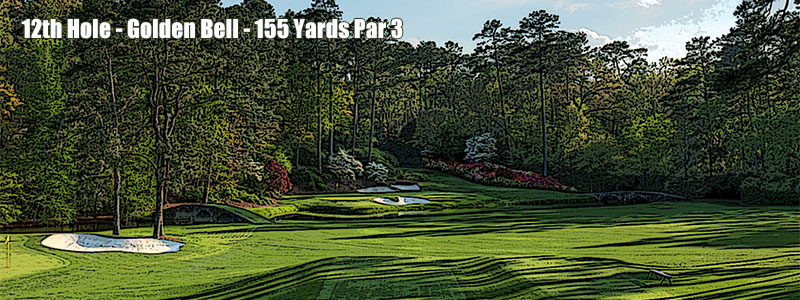アーメン・コーナー|Amen Corner のお話
| 11. White Dogwood (505 yards - Par 4) |
| 12. Golden Bell (155 yards - Par 3) |
| 13. Rae's Creek (510 yards - Par 5) |
| Augusta National Golf Club |

オーガスタ・ナショナル G.C. の各ホールには 名前が付いているが インの最初の長いダウンヒルのパー 4 カメリア (Camellia) に続くのが アーメン・コーナーの始まる 11番ホール、右ドッグレッグのパー 4 ホワイト・ドッグウッド (White Dogwood) である。打ち下ろしとなる グリーンへのセコンド・ショットは 左の池と 右のバンカーにプロテクトされている。1987年 マスターズのプレーオフで ラリー・マイズ (Larry Mize) が グリーン右手前からのピッチショットでホールアウトし グレッグ・ノーマン (Greg Norman) を破ったシーンは この 11番ホールでの出来事だ。(YouTube 動画は そのプレーオフ 英語音声付き)
その後に続くのが フックボールのティーショットで フェアウェイを捕らえれば グリーン手前のクリーク (Rae's Creek) 越えのセカンド・ショットで イーグルを狙うことも出来る 短い 左ドッグレッグ・パー 5 の 13番ホール アゼリア (Azalea) である。このホールの左側には 細いクリークが流れているが、そのクリークの周りには 美しいアゼリア(1600本)の花が咲き乱れ、そのホールの名前の由来になっている。1978年大会で 中島常幸選手(アメリカでは Tommy Nakajima で知られる) が ここで 13 というスコア出してしまったが そのエピソードは 今でも アメリカで(テレビ中継の時などに)語り継がれる お話になってしまった。
♦ アーメン・コーナー:その難しさの訳
いずれにしても、これらの 3ホールは コースの高台にある訳ではないが 風が強いことが多く スコアを伸ばせる選手とスコアを崩してしまう選手の明暗が分かれる所として知られている。その難しさの訳を解説しているのが 以下の動画である。英語の動画だが 動画の下の解説を読んでから その映像を見て欲しい。
11番ホールは その距離も長いが グリーンへのショットが 極端な (9~12m) ダウンヒルで さらに そのターゲットとなるグリーン左手前に 池が入り込んでいる。風の影響が大きい中で 小さなターゲットに ボールを落とさなければならないのである。そして、12番ホールは 僅か 155ヤードのショート・ホールであるが そのグリーンが 11番ホールと 13番ホールのフェアウェイから流れ込む風が合流して その風速を増す形で渦を巻く (Eddy Effect) 現象が見られる所で 他の場所の 2倍から 3倍の風速になることも珍しくないだけでなく その風向きが 読み難いから 非常に厄介な訳だ。通常 10mph の横風が吹くと この距離のショットで ボールは 8ヤード横に流されると言うが、どの方向から どのくらいの風が吹いているのか 迷うようなことになれば ショットが ピンに絡むことは殆どない。そして、13番ホールは スコア・アベレージ的には このコースで 2番目に易しいホールだが ドッグレッグしている フェアウェイが左に (11°) 大きく傾斜しているために グリーンをセカンド・ショットで狙える所にティーショットを運ぶためには 正確なティーショットを打つことが要求される。大きく曲がるボールで 精度の高い方向性を確保するのは トップ・プロと言えども 決して 簡単なことではない。
♦ アーメン・コーナー:名前の由来
この3ホールが アーメン・コーナーと呼ばれるようになったのは 実は 1958年からのことである。1958年のマスターズ最終日の 12番ホールで ピッチマークにボールが くい込んだ時のルールに係わる もめ事があったが アーノルド・パーマーが 猛追を見せて その日のリーダーだった ケン・ベンチュリー (Ken Venturi) を破って優勝した時の記事 (英語の原文を最後に付記したので興味のある方は そちらを参照下さい)を書いたスポーツ・イラストレイテッド誌 (Sports Illustrated) の記者ハーバート・ウィンド (Herbert Warren Wind) が その記述に アーメン・コーナー (Armen Corner) という言葉を初めて使ったが それ以来 この言葉が広く使われるようになったのだ。
この年の最終日の 12番ホール、ゴールデン・ベルで パーマーの打ったティー・ショットが グリーン奥のラフで ピッチ・マークにくい込んでいたが(» ルール詳細)現場に居た競技委員は 救済を認めなかったため、パーマーは そのボールを そのままプレーし ダブル・ボギーとなった。しかし、納得が行かなかったパーマーは 救済が受けられるはずだと主張し、2つ目のボールをプレーして パーをセーブ。そして、そのクレームが 後になって 認められ 優勝したというエピソードがあった。なお、この日は 雨の後で ローカル・ルールが設定され、スルー ザ グリーンで 自分のピッチ・マークにくい込んだボールは 救済を受けることが出来たのである。
一方、このプレーに対して ケン・ベンチュリーは異議を唱えており、パーマーが 2つ目のボールをプレーするのであれば 最初のボールをプレーする前に その宣言をしなければ 2つ目のボールのスコアは認められるべきではないとのクレーム(正論)を付けたが パーマーの優勝は 正式のものになった訳だ。ケン・ベンチュリーの主張は 宣言をせずにボールを打った時に、そのショットが好ましい結果であれば パーマーはクレームをしなかったはずだから 2つ目のボールを打つ宣言をせずに 後になってクレームすることは出来ないと言う論拠で 理に適っている。現場に居た競技委員の不適切な対応で起きた事件であるが、競技委員も ゴルフのルールも 完全ではないから クレームする時の論拠やタイミングが如何に重要か ということを考えさせられる逸話でもある。
実は ハーバート・ウィンドが この出来事を記事にした時に ゲームの行方の鍵を握るコーナー(場所)というニュアンスのある野球のホット・コーナー (hot corner) やバスケットボール、フットボール用語のコフィン・コーナー (coffin corner) のような言葉を考えたそうだが その時に思いついた言葉が Amen Corner だったと言うのだ。当時 知られていたジャズのナンバーに Shoutin' in that Amen Corner という曲があったが(その昔、聖書の製本所が 沢山あった マンハッタンの一角が Amen Corner と呼ばれていたそうで、ジャズの曲名は その辺りから来ているそうだ)その言葉が浮かんで、その記事の中で それを使ったのだと言う。興味のある方は、その時に ハーバート・ウィンドが書いた記事の原文を(内容は 前述の出来事の記述のとおりだが)ご覧下さい。
Now the drama began to unfold, and because of the unusual setting it was indeed charged with the quality of theater: only the players, their caddies and officials are allowed beyond the roping around the 12th tee, and one could only watch the pantomime activity taking place on the distant stage of the 12th green and try to decipher what was happening. To begin with, there was an animated and protracted discussion between Palmer and a member of the tournament rules committee, obviously on the subject as to whether or not Palmer could lift his ball without penalty. Apparently the official had decided he couldn’t, for Arnold at length addressed the half-buried ball and budged it about a foot and an half with his wedge. It ended up in casual water then, so he lifted and dropped it (patently without penalty) and then chipped close to the pin on his third stroke. He missed the putt and to a 5. This put him a stroke behind Venturi.
Then the situation became really confusing. Palmer did not walk off the green and head for the 13th tee. He returned to the spot in the rough just behind the apron where his ball had been embedded and, with the member of the rules committee standing by, dropped the ball over his shoulder. It rolled down the slope a little, so he place the ball near the pit-mark. Apparently, now, the official had not been sure of what ruling to make and Palmer was playing a provisional or alternate ball in the event it might later be decided he had a right to lift and drop without penalty. He chipped stone-dead again and this time holed the putt for a 3. Now the question was: Was Palmer’s score a 3 or 5?
Granting the difficulty of the job, it was nonetheless unfortunate that the member of the rules committee working the 12th hole sector didn’t know his job well enough to make an immediate and proper decision on the buried ball. In truth, as rules go, it wasn’t a really tough one or an involved one. Because of the soggy condition of parts of the course after the heavy rains, the tournament committee had involved for the final day of play a local rule permitting the players to lift, clean, and drop without penalty any ball which became embedded "through the green" in its own pit-mark. (You will find this explained under "Local Rules" on page 58 of the 1958 USGA Rules Book.) Since the term " through the green" takes in all parts of the course except trees, greens, sand traps, and water hazards, it clearly applied to the rough in which Palmer’s ball pitched and stuck. One possible explanation of the indecisiveness of the official who was handling the 12th was the fact that the ball was embedded only a foot or so below the bankside trap and, since some of the sand had been washed out of the traps by the rains, he may have been uncertain whether or not the area in question was rough or part of the hazard. However, the ball clearly lay below the well-defined outline of the trap.
All in all, it was unfortunate that the rules question arose at such a crucial juncture of the tournament, and it was extremely fortunate that the confusion which developed did not untowardly affect the play of the contenders or the ultimate winning and losing of the tournament.
以上、アーメン・コーナーという言葉の意味だけでなく、その言葉の持つニュアンスが お分かり頂けただろうか。
| マスターズのお話 | マスターズの記録 |
| コースを空から見てみよう | ホールインワンのお話 |
| 球聖 ボビー・ジョーンズ | マスターズ・公式サイト |




